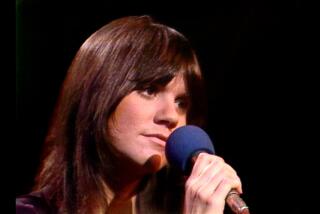TV Magic: What You See Is What You Really Get
Thirty years ago, TV stations told magicians there was one impossible feat that even they couldn’t pull off: presenting magic on television. “People will just believe that it’s television trickery,” they were told. “Magic doesn’t work on television.”
Today, dozens of magic specials and magic-themed series later, those ideas have practically vanished and prime-time prestidigitation is now a common commodity.
Saturday night at 8 on CBS, (Channels 2, 8) there’s “The Magic of David Copperfield X,” an hourlong special that features the suave magician exhibiting various tricks of his trade, including an on-location disappearance into the mysterious Bermuda Triangle.
The show also mixes segments taped before an audience at Caesars Palace in Las Vegas with rock video-style magical vignettes.
Despite the acceptance of magic shows on television, however, magicians remain concerned about convincing viewers that the illusions rely on the magician’s skill, not camera tricks. Many believe that if just one magician weakens the public’s belief that the illusions are legitimately accomplished, then the credibility of all magic on TV could be compromised.
“As soon as the audience suspects (trick photography),” said magician Doug Henning, “the wonder is taken away and the magic loses its purpose.”
Most small-screen sorcerers try to follow the criteria for on-air magic that magician Mark Wilson, a pioneer of TV conjuring, developed back in the ‘50s:
--Perform the magic before an audience and broadcast the show live when possible.
--Keep the camera on the illusion until it’s completed. Magicians, for example, do not put a girl in a box, cut to something else with another camera, and then cut back to show that the girl has vanished.
--Use a disclaimer to announce that the show uses no camera trickery.
Some magicians go to even more elaborate lengths. In the early ‘70s, Wilson performed his six “Magic Circus” specials in the round, with a live audience on all sides.
Henning’s eight “World of Magic” specials often used hand-held cameras to exhibit all angles of his illusions.
“Magic on television can be the best magic,” said Henning. “The camera can look in and around the illusion to show there are no hidden trapdoors.
“When you see a magician on stage, you can’t go up close, but the camera can. The camera can be used as a tool to heighten the wonder.”
In the 1980s, as magic specials became more commonplace, Copperfield began tinkering with the frontiers of television magic. Some of the experiments in his nine big-budget specials, featuring large-scale illusions like the vanishing of a 7-ton jet and the Statue of Liberty, have been viewed by other magicians with concern.
One problem, some say, is that portions of Copperfield’s shows--filmed with lush cinematography and without a live audience--distance the magic too far from reality to be believable.
Copperfield agreed that the film look sometimes presents difficulties.
During an escape from Alcatraz prison featured in his last special, Copperfield said, “I explained that, ‘What you are seeing is not a TV movie.’ Well, the next thing that happens is the room takes on a cinematic quality. I had a smoke machine in the cell with me to add a bit of texture to the shot.”
Copperfield defended his approach to TV by pointing out that viewers can see duplications of his illusions during his live performances. “Come and see my live shows and you’ll see that the stuff is real,” he said.
On Saturday, viewers can decide for themselves if the exciting camera cuts of Copperfield’s Bermuda Triangle sequence make it movielike or believable.
Wilson worries about the use of editing to quicken the pace of magic sequences on TV. That approach, Wilson and others say, can make convincing the viewer all the more difficult.
Henning also fears the effects of overproduced specials. “The way to overcome that is to have magicians start doing magic live on television again,” he said, “because the audience has become very skeptical.”
More to Read
The complete guide to home viewing
Get Screen Gab for everything about the TV shows and streaming movies everyone’s talking about.
You may occasionally receive promotional content from the Los Angeles Times.






